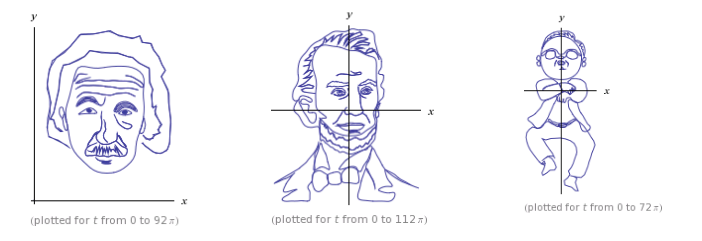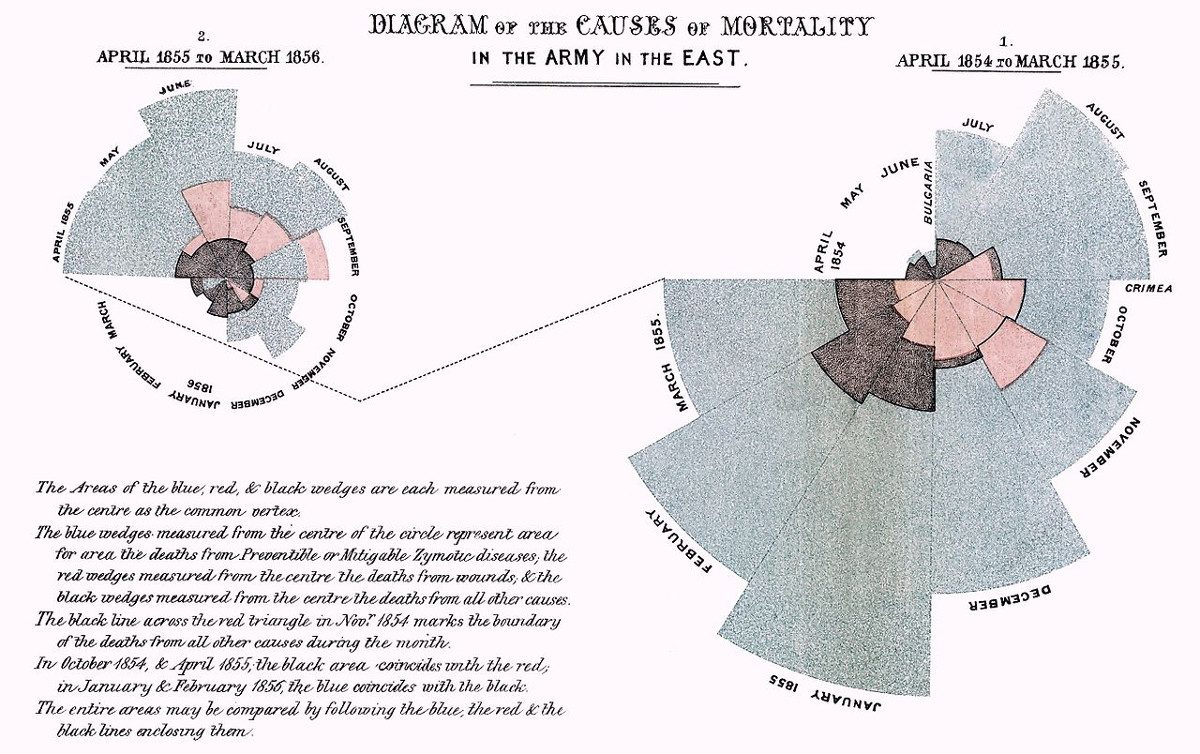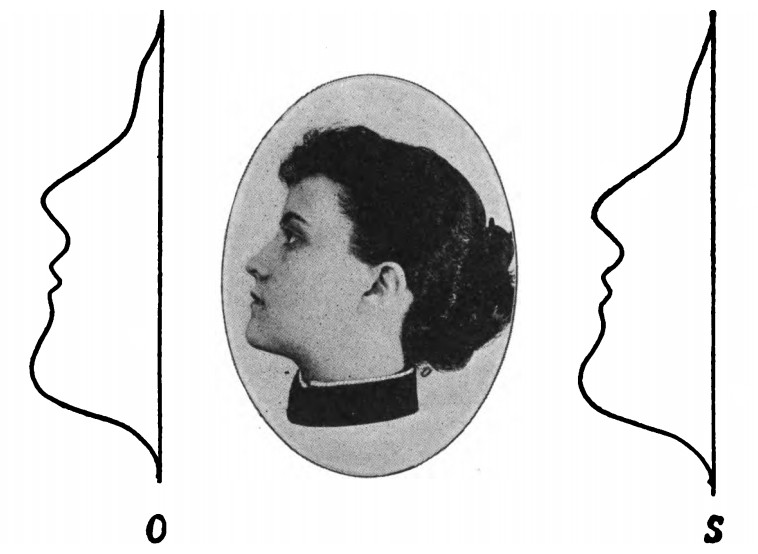
Wolfram Alpha has a collection of parametric curves that produce portraits of famous people — above are Albert Einstein, Abraham Lincoln, and PSY.
Wolfram chief scientist Michael Trott explains how it’s done in three blog posts.
(Thanks, Danesh.)

Wolfram Alpha has a collection of parametric curves that produce portraits of famous people — above are Albert Einstein, Abraham Lincoln, and PSY.
Wolfram chief scientist Michael Trott explains how it’s done in three blog posts.
(Thanks, Danesh.)
It’s well known that the sum of the cubes of the first n integers equals the square of their sum:
13 + 23 + 33 + 43 + 53 = (1 + 2 + 3 + 4 + 5)2
California State University mathematician David Pagni found another case in which the sum of cubes equals the square of a sum. Take any whole number:
28
List all its divisors:
1, 2, 4, 7, 14, 28
Count the number of divisors of each of these:
1 has 1 divisor
2 has 2 divisors
4 has 3 divisors
7 has 2 divisors
14 has 4 divisors
28 has 6 divisors
Now cube these numbers and sum the cubes:
13 + 23 + 33 + 23 + 43 + 63 = 324
And sum the same set of numbers and square the sum:
(1 + 2 + 3 + 2 + 4 + 6)2 = 324
The two results are the same: The sum of the cubes of these numbers will always equal the square of their sum.
(David Pagni, “An Interesting Number Fact,” Mathematical Gazette 82:494 [July 1998], 271-273.)
03/10/2017 UPDATE: Reader Kurt Bachtold points out that this was originally discovered by Joseph Liouville, a fact that I should have recalled, as I’d written about it in 2011. (Thanks, Kurt.)
Berkeley software engineer Stephen Malinowski creates animated graphical scores of musical works.
“The vertical positions of the bars on the screen represent the relative pitches, while the color can represent instruments or voices, thematic material or tonality,” explains Crétien van Campen in The Hidden Sense. “When they are synchronized, the sound and image are easily linked in our perception. Musical structures like Bach’s canons or his many-voiced compositions thus become understood and accessible by means of a visual aid.”
There’s much more on Malinowski’s YouTube channel; here are some of his favorites.
At one point in Samuel Beckett’s 1951 novel Molloy, the title character finds himself at the seaside and “lays in a store of sucking stones”:
They were pebbles but I call them stones. Yes, on this occasion I laid in a considerable store. I distributed them equally between my four pockets, and sucked them turn and turn about. This raised a problem which I first solved in the following way. I had say sixteen stones, four in each of my four pockets these being the two pockets of my trousers and the two pockets of my greatcoat. Taking a stone from the right pocket of my greatcoat, and putting it in my mouth, I replaced it in the right pocket of my greatcoat by a stone from the right pocket of my trousers, which I replaced by a stone from the left pocket of my trousers, which I replaced by a stone from the left pocket of my greatcoat, which I replaced by the stone which was in my mouth, as soon as I had finished sucking it. Thus there were still four stones in each of my four pockets, but not quite the same stones.
It occurs to him that this method won’t ensure that every stone is eventually sucked, and he works out a plan that will achieve this. This takes eight pages, “one of the longest and most detailed accounts of someone working at a mathematical problem in a work of fiction,” according to Richard Phillips in Numbers: Facts, Figures and Fiction.
Maddeningly, in the end Molloy throws away all the stones but one, “for they all tasted exactly the same.”

In 1970, shortly after the first lunar landing, rocket scientist Ernst Stuhlinger received a letter from missionary Sister Mary Jucunda in Zambia asking how the government could justify spending billions of dollars on space exploration when so many children on Earth were starving to death. He responded with a story:
About 400 years ago, there lived a count in a small town in Germany. He was one of the benign counts, and he gave a large part of his income to the poor in his town. This was much appreciated, because poverty was abundant during medieval times, and there were epidemics of the plague which ravaged the country frequently. One day, the count met a strange man. He had a workbench and little laboratory in his house, and he labored hard during the daytime so that he could afford a few hours every evening to work in his laboratory. He ground small lenses from pieces of glass; he mounted the lenses in tubes, and he used these gadgets to look at very small objects. The count was particularly fascinated by the tiny creatures that could be observed with the strong magnification, and which he had never seen before. He invited the man to move with his laboratory to the castle, to become a member of the count’s household, and to devote henceforth all his time to the development and perfection of his optical gadgets as a special employee of the count.
The townspeople, however, became angry when they realized that the count was wasting his money, as they thought, on a stunt without purpose. ‘We are suffering from this plague,’ they said, ‘while he is paying that man for a useless hobby!’ But the count remained firm. ‘I give you as much as I can afford,’ he said, ‘but I will also support this man and his work, because I know that someday something will come out of it!’
Indeed, something very good came out of this work, and also out of similar work done by others at other places: the microscope. It is well known that the microscope has contributed more than any other invention to the progress of medicine, and that the elimination of the plague and many other contagious diseases from most parts of the world is largely a result of studies which the microscope made possible.
The count, by retaining some of his spending money for research and discovery, contributed far more to the relief of human suffering than he could have contributed by giving all he could possibly spare to his plague-ridden community.
Stuhlinger’s whole letter is here (PDF). “Although our space program seems to lead us away from our earth and out toward the moon, the sun, the planets and the stars,” he wrote, “I believe that none of these celestial objects will find as much attention and study by space scientists as our earth.”
In 1895, when a Chicago landowner failed to pay his taxes, a bidder acquired a claim to the east one-vigintillionth part of the lot. The insurance company tried to foreclose, arguing that the owner had allowed a cloud to come on the title by the loss of this small fraction. But the county court held that a vigintillionth (1/1000000000000000000000000000000000000000000000000000000000000000) was practically nothing, as “its width would be so fine that the most powerful magnifying glass ever made could not discover it: it would be utterly incapable of physical possession.” In a little rhapsody, the Northwestern Law Review agreed:
If the surface of the earth were rolled out flat and a vigintillionth sold off the east side and sold to pay the taxes of the owner thereof, the purchaser at the tax sale would get a strip about 500 quin-decillionths of an inch wide. Hardly large enough for even a Pingree potato patch.
If the holder of the fee simple title to the section of space between the earth and the sun, (taken at 93,000,000 miles), should be unfortunate enough to be sold out to the tax buyer, he would, if he failed to redeem, lose title to a strip along one side of his holding, (say next the sun), some 140 qual decillionths of an inch in width.
Or, if the ‘unknown owner’ of the space between here and the nearest fixed star, (Alpha Centauri), something like twenty million millions of miles from the Northeast corner of Randolph and State Sts. should be unfortunate in his real estate venture and fall into the greedy hands of the tax buyer, he would have to yield up dominion over a strip on the East side of his subdivision some 645 dio decellionths of an inch across.
So did the Economist. But a higher court reversed the ruling, arguing that although a vigintillionth of the property “could not be appreciated by the senses, it is recognizable by the mind,” and that its existence left the rest of the property inaccessible by the street on the east side.
This must be some odd trend of American law in the 1890s — in his Strangest Cases on Record (1940), John Allison Duncan mentions another such case in Arapahoe County, Colorado. He includes a photograph of the certificate of purchase.

Florence Nightingale created this innovative diagram to track the causes of mortality in the Crimean War. Her description:
The Areas of the blue, red, & black wedges are each measured from the centre as the common vertex.
The blue wedges measured from the centre of the circle represent area for area the deaths from Preventable or Mitigable Zymotic diseases, the red wedges measured from the centre the deaths from wounds, & the black wedges measured from the centre the deaths from all other causes.
The black line across the red triangle in Nov. 1854 marks the boundary of the deaths from all other causes during the month.
In October 1854, & April 1855, the black area coincides with the red, in January & February 1856, the blue coincides with the black.
The entire areas may be compared by following the blue, the red, & the black lines enclosing them.
The diagram on the right corresponds to the first 12 months of the war; the one on the left shows the second 12 months. The difference reflects the dramatic effectiveness of a sanitary commission in reducing disease.
Nightingale found that presenting information graphically made it more accessible to Members of Parliament and civil servants, who might not otherwise read statistical reports. In 1859 she was elected the first female member of the Royal Statistical Society.

In 1982, computer scientists Edward Fredkin and Tommaso Toffoli suggested that it might be possible to construct a computer out of bouncing billiard balls rather than electronic signals. Spherical balls bouncing frictionlessly between buffers and other balls could create circuits that execute logic, at least in principle.
In 2011, Yukio-Pegio Gunji and his colleagues at Kobe University extended this idea in an unexpected direction: They found that “swarms of soldier crabs can implement logical gates when placed in a geometrically constrained environment.” These crabs normally live in lagoons, but at low tide they emerge in swarms that behave in predictable ways. When placed in a corridor and menaced with a shadow representing a crab-eating bird, a swarm will travel forward, and if it encounters another swarm the two will merge and continue in a direction that’s the sum of their respective velocities.
Gunji et al. created a set of corridors that would act as logic gates, first in a simulation and then with groups of 40 real crabs. The OR gate, where two groups of crabs merge, worked well, but the AND gate, which requires the merged swarm to choose one of three paths, was less reliable. Still, the researchers think they can improve this result by making the environment more crab-friendly — which means that someday a working crab-powered computer may be possible.
(Yukio-Pegio Gunji, Yuta Nishiyama, and Andrew Adamatzky, “Robust Soldier Crab Ball Gate,” Complex Systems 20:2 [2011], 93–104.)

The historian Socrates tells us that the Emperor Tiberius, who was much given to astrology, used to put the masters of that art, whom he thought of consulting, to a severe test. He took them to the top of his house, and if he saw any reason to suspect their skill, threw them down the steep. Thither he took Thrasyllus, and after a long consultation with him, the emperor suddenly asked whether the astrologer had examined his own fate, and what was portended for him in the immediate future. Now the difficulty is this: If Thrasyllus says that nothing important is about to befall him, he will prove his lack of skill and lose his life besides. If, on the other hand, he says that he is soon to die, either the emperor will set him free, in which case the prophecy was false and he ought to have destroyed him; or Tiberius will destroy him, while he ought to have spared him as a true revealer of the future. Of course the solution is easy. Thrasyllus, after some observations and calculations, began to quake and tremble greatly, and said some great calamity seemed to be impending over him, whereupon the emperor embraced him and made him his chief astrologer.
— The Ladies’ Repository, July 1873

In his 1916 book The Science of Musical Sounds, Dayton Clarence Miller uses harmonic analysis to convert the line of a woman’s profile (left) into an equation of 18 terms. Then he uses this equation to reproduce the profile synthetically (right). “If mentality, beauty, and other characteristics can be considered as represented in a profile portrait,” he writes, “then it may be said that they are also expressed in the equation of the profile.”
He repeats the synthesized profile to produce a waveform:

“In this sense beauty of form may be likened to beauty of tone color, that is, to the beauty of a certain harmonious blending of sounds.”
In Noise, Water Meat: A History of Sound in the Arts, Douglas Kahn writes, “The simple beauty of the female expressed in the line thus becomes also the simple beauty of mathematics, graphic representation, and instrumentation, let alone mediation and reproduction, involved in the production of the equation and profile. Thus, we move beyond Lord Kelvin’s fascination with a beauty of mathematics to a fascination with a mathematics of beauty.”